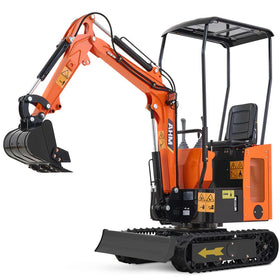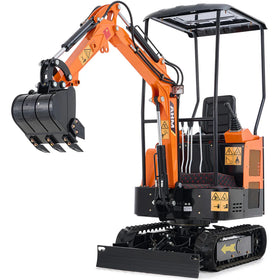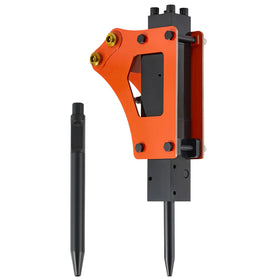The traditional excavator stands as an indispensable heavy-duty equipment for construction endeavors involving demolition, foundation digging, and mining.
(Reading Time: 3-5 Minutes)
What is a Compact Excavator?
The micro excavator, often referred to as a mini excavator, is the preferred tool for projects demanding maneuverability in confined spaces. This includes tasks such as small building projects, home renovations, pool installations, and trench digging.
The key advantage of compact excavators, or mini excavators, lies in their efficient size, allowing for significant digging depth even in limited spaces.
Various factors should be taken into account when choosing between mini excavators and standard excavators, including:
- Tail Swing
- Maximum Dig Depth
- Maximum Dump Height
- Operating Weight
These factors play a crucial role in determining the suitable excavator for a particular task and whether a standard excavator might be a more viable option.
What is Zero Tail Swing?
A critical factor enhancing the overall performance of a mini excavator is zero tail swing. Excavators are available with conventional, reduced, or zero tail swing configurations. Tail swing depends on the size and placement of the operator's cab in relation to the excavator's tracks and counterweight.
Conventional tail swing excavators feature a counterweight extending beyond the machine's tracks, commonly found in larger excavators for increased stability.
On the other hand, zero tail swing excavators have a counterweight that remains within the cab's perimeter, allowing mini excavators to work with agility within confined spaces, such as fenced-in areas and along busy roadways.
What is Maximum Dig Depth?
Maximum dig depth refers to the depth to which an excavator can dig into the earth. The weight of a mini excavator can impact its dig depth, with smaller excavators potentially limited in trench depth compared to larger counterparts.
This metric differs from an excavator's maximum depth of a vertical wall, which signifies how deep a compact excavator can dig a completely vertical wall. The maximum vertical wall depth is never as much as the excavator's maximum dig depth.
What is Maximum Dump Height?
Maximum dump height is another crucial specification for mini excavators, denoting the highest point an excavator's arm can reach to empty its bucket attachment. This measurement is especially significant when considering mini excavator sizes, as it can impact the heavy equipment operator's ability to work on a project. Smaller excavators may have a limited dump height compared to larger or standard excavators.
Selecting an excavator with a dump height higher than the material's destination, such as a dump truck or other surface, ensures efficient material transfer.
What is Operating Weight?
A mini excavator's weight is typically defined as its operating weight, accounting for the machine's weight in action, including added weight from fuel, attachments, and the operator. Model operating weight varies significantly among mini excavators and larger models. This metric is crucial when determining the overall weight of a mini excavator.
Differentiating between Loaded Weight and Unloaded Weight Unloaded weight reflects the machine's weight before lifting, digging, or carrying additional materials or attachments. Loaded weight, on the other hand, represents the mini excavator's weight with a full bucket or an attachment added.
Each machine has loaded weight limits specified by the manufacturer, emphasizing the importance of adhering to these limits to prevent tipping, ensure safety on the job site, and avoid machine damage.
Calculating the appropriate loaded weight limit ensures a balance between efficacy and safety standards, preventing machine repairs and downtime.
How Much Does a Mini Excavator Weigh?
The average mini excavator typically weighs between 2,000 and 10,000 pounds. The total weight depends on the make and model, as well as the attachments on each machine. The weight of a mini excavator varies based on its intended use, emphasizing the importance of choosing the right size for specific tasks.
Significance of Mini Excavator Weight
Compared to larger models, mini excavators, or compact excavators, are considerably easier to transport to and from job sites, store between projects, and maneuver in tight spaces. This makes them ideal for small demolition jobs and projects in small or narrow areas.
Attachments for Mini Excavators
Mini excavators boast versatility with a range of attachments to choose from. Some popular attachments and their weight additions to the machine's operating weight include:
- Hydraulic Thumb: adds 60 - 110 pounds
- Trenching Bucket: adds 145 - 290 pounds
- Hydraulic Breaker: adds 410 - 1160 pounds
- Auger Attachment: adds 151 - 217 pounds
Accounting for attachment weight ensures that the small excavator is not overloaded, preventing damage and ensuring operator safety.
Popular Mini Excavators
- Yanmar VIO35-6A (8,214 pounds)
- John Deere 30G (7,220 pounds)
- Doosan's DX35-5 (8,193 pounds)
- Case CX37C (7,990 pounds)
- AHM 1601 (Net Weight: 1940 pounds)
- Kubota KX040-4 (9,195 pounds)
Common Uses of Mini Excavators
Mini excavators excel in job sites with limited space or that require a machine capable of fitting into small or narrow areas. Their near-zero tail swing design allows for safe operation near buildings and structures without posing a threat. They provide enhanced accuracy when digging in tight spaces or areas with buried gas lines or pipes.
Owners and operators appreciate mini excavators for their ease of transport, better fuel economy, and suitability for a variety of jobs, including:
- Pool installation
- Digging graves
- Pipe repair
- Landscaping
- Renovations
- Tree harvesting
- Small demolition jobs
Mini excavators, when operated safely, prove to be valuable additions to equipment fleets. Understanding the machine's weight and attachment considerations contributes to a longer lifespan and adherence to safety standards.
Frequently Asked Questions (FAQ)
Q1: What is the typical operating weight of a compact excavator?
A: The operating weight of compact excavators usually ranges from 1 to 7 tons. The exact weight can vary depending on the model and configuration.
Q2: Why is the weight of a mini excavator so important for transport and operation?
A: Weight plays a key role in determining whether the equipment can be transported on a light trailer, and it also affects stability during work, fuel efficiency, and wear and tear on the machine. Lighter machines are generally better suited for tight spaces and easier handling.
Q3: What are some common factors that influence the weight of a compact excavator?
A: Besides the base machine weight, factors such as the type of tracks (rubber or steel), the configuration of the hydraulic system, engine power, and any attached accessories all contribute to the overall weight.
Q4: Are there any safety weight limits to keep in mind when using a compact excavator?
A: Yes, manufacturers provide maximum load and operating weight guidelines to ensure safe use. Exceeding these limits might lead to instability or tipping, so it’s always best to follow the recommended specifications carefully.
Q5: What are some common maintenance tips and potential issues related to mini excavator weight?
A: Some frequent issues include engine starting troubles, noisy hydraulics, and loose tracks. Regularly checking the battery, hydraulic fluid levels, and filters, along with timely repairs, can help prolong the equipment’s lifespan and maintain safety.







